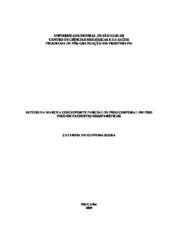Estudo da marcha com suporte parcial de peso corporal em piso fixo em pacientes hemiparéticos
Abstract
Gait recovery is a one of the main goals of a rehabilitation program for hemiparetic individuals after stroke. Among the different approaches of gait training, the use of systems of partial body weight support (BWS) on treadmill has provided improvements in the pattern of movement of these individuals. However, the strategies adopted to walking on treadmill are different from the ones adopted to walking overground, and overground level is the more usual type of area, it is important to analyze the movement of these individuals while they use the SPPC on overground level, and investigate the effects of the gait training with BWS on ground level. Therefore, this dissertation is composed of two studies. The goal of the first study was to analyze the gait of
chronic hemiparetics individuals with and without the system of BWS. For such, 13 chronic hemiparetics individuals were evaluated on three conditions: 1) walking freely with or without assistance; 2) walking with the use of harness of BWS system, however without relief of body weight; 3) walking with the use of harness of BWS system, with 30% body weight relief. Walking speed, cadence, stride length and speed, first and second double support, single support, and swing durations, range of motion (ROM) of ankle, knee, and hip joints, and foot, shank, thigh, and trunk segments of nonparetic and paretic limbs were analyzed on the three conditions. It was found that during the gait with 30% of BWS, participants reduced the speed of locomotion and stride length and speed. However, no effect was observed for temporal asymmetry. The ROM of hip, thigh, and trunk decreased on the 30% of BWS condition, and the trunk had become more upright. Although use of BWS system without relief of body weight has not changed the speed of locomotion, this condition has the same changes that the 30% of BWS conditions, however, more discreet. The changes found in the first study may be attributed to little time to
adapt to the gait conditions on overground level with BWS and to the relief of body weight in the lower limbs. The second study aimed to analyse the effects of gait training with BWS on overground level in the gait of chronics hemiparetics. Thus, 12 chronics hemiparetics submitted
to sessions of 45 minutes, three times a week, for six weeks participated in this study. The individuals were evaluated walking freely at self-selected comfortable speed before and after the training. The variables examined were walking speed, step length, stride length and speed, first and second double support, and single support durations, maximum and minimum angles, and ROM of foot, shank, thigh, and trunk segments of paretic and nonparetic limbs. After the training
period, these individuals walked faster, with symmetry steps, and strides longer and faster. The asymmetry between paretic and nonparetic limbs remained for single support duration, and for ROM and, for maximum and minimum angles for all the segments. The minimum angles of foot and shank, maximum angle of thigh, and the ROM of all segments increased. This approach to training may be used as safe, specific, and promising alternative for gait recovery after stroke. Because this approach of BWS training on overground level is recent, further studies are needed to explore different percentages of weight relief and other stages of strokes, for example, in acute individuals hemiparetics.
